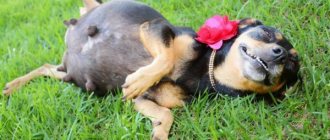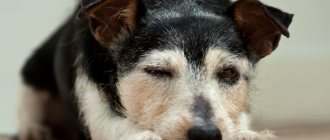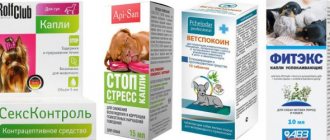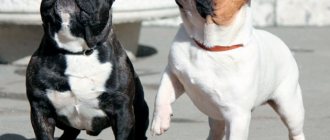The female puppy sweetie quickly becomes a pretty mature lady. There is something inevitable about a dog’s growing up that every owner should be aware of. A dog's estrus is a natural process, indicating that the female puppy has already become an adult and can take part in mating and bearing puppies herself. We invite you to learn more about what estrus is in dogs and what owners can do about it.
What is estrus
To understand how to behave with a dog during heat, you need to know more about its physiology. Estrus (estrus, mating, heat) is a natural process. This is only the specificity of the organism, indicating the possibility of having offspring. It is during this period that bitches clearly manifest their desire to communicate with male dogs, which, as a logical result, leads her to pregnancy.
global $ads_google; //data-ad-slot=”2475549904″ $ads_google = empty($ads_google) ? false : true; ?> if ($ads_google == false) {?>
$ads_google = true; ?> } ?>
Stages of sexual hunting
Let us consider in detail what stages estrus consists of.
1. Proestrus (pre-temperature) lasts from 7 to 10 days. Blood flows to the genitals, causing the vulva to gradually swell. At this time, the owner notices the first bleeding. This is not the time for mating, but only the initial period of preparing the body for it.
Behavior changes: increased excitability, the dog either plays or begins to obey poorly. On the street he makes marks with urine. Flirting with males ends with her growling and jumping away.
2. Estrus (rutting). In the very first days from the beginning of this stage, ovulation occurs, but the bitch can also allow males in for several days after this.
The characteristics of discharge in different breeds of dogs at the third stage may differ. In any case, it is considered normal if the color of the discharge when ready for mating is light pink. The discharge may stop, but the vulva will be very swollen.
The female willingly allows the males to approach, “greeting” them by raising her pelvis and pulling up the loop with her tail retracting and typical freezing.
3. The duration of metaestrus is several days. At this time, the heat begins to stop. The reddish discharge ends, the loop becomes smaller, and males are no longer of interest.
If pregnancy does not occur, the body returns to its normal state. It is important to understand that during metaestrus, the “pregnancy hormone” (progesterone) remains elevated, and fertilization may not have occurred. This can lead to a false pregnancy.
4. Anestrus is called sexual dormancy. The period lasts from 100 to 150 days.
Sexual cycle in dogs
» Biovetlab.ru » Publications » Reproductive cycle in dogsFishing online store
There is a division of animals based on the rhythm of the sexual cycle into mono- and polycyclic. The first group includes animals with 1 sexual cycle per year. In polycyclic animals, several cycles occur, which are repeated with a certain frequency during the season or the whole year, depending on the type of animal. It is difficult to classify dogs into any particular of these groups, since they can have 1-2 or even 3 sexual cycles throughout the year. Therefore, some authors classify dogs as monocyclic, while others consider them dicyclic animals.
A number of signs prevail that indicate that dogs should be classified as monocyclic animals. For example, representatives of wildlife from the canine family (wild dogs Dingoes, wolves, jackals, coyotes) have only one sexual cycle per year and at a strictly defined time of year. And domestic dogs have a lot in common with them and can be crossed. In addition, females experience estrus after the aestrous period, which is also typical for monocyclic animals. The increase in the number of cycles in dogs and their independence from the seasons arose during the process of their domestication.
As a rule, the period of sexual activity of females is determined by the interestrous period. The fact is that establishing the duration of the reproductive cycle of dogs and the time of its completion is possible only with the use of laboratory research methods. To do this, the dynamics of the hormone progesterone in the blood and the nature of vaginal smears are analyzed. The duration of the interestrous period can be different and varies depending on the breed.
The duration of the interestrous period does not depend on pregnancy. The reproductive cycle of dogs is special and differs significantly from the cycle of other domestic and farm animals. Before the start of sexual heat, bitches develop hemorrhagic discharge resulting from diapedesis. When sexual heat occurs, an immature egg ovulates, which can be fertilized 2-3 days from the moment it enters the oviduct. By the end of sexual heat, an active corpus luteum is formed. Unlike dogs, in other animals the corpus luteum is formed at the end or after sexual heat, and a separate stage of the cycle is distinguished - metestrus (inhibition period). This is followed by a period of sexual rest - anestrus.
Thus, the reproductive cycle of dogs is divided into 4 phases, or stages:
- proestrus;
- estrus;
- diestrus;
- anestrus.
Let us consider each of these stages in more detail.
Proestrus ( precursor)
.
The duration of this phase is approximately 9 days. Its signs are bloody vaginal discharge and swelling of the vulva. Depending on the breed, the intensity of the discharge varies; it may not be noticeable at all if the dog licks it. Urination becomes more frequent. Towards the end of the phase, the bitch begins to attract males, but does not allow intercourse. At the same time, there is a small probability of ovulation, and a few days later - fertilization.
Estrus
Estrus, like pre-gestation, lasts approximately 9 days. During this period, the vulva becomes softer. The first sign of the onset of the phase is the individual’s readiness for intercourse. At the same time, the discharge becomes thinner and less abundant. This is typical only for those bitches who experienced intense discharge during the proestrus phase. As already mentioned, depending on the breed, dark-colored discharge may be slight and continue during the first three periods of the sexual cycle. Ovulation occurs either at the very beginning of estrus, or on days 2-4.
Metestrus
(diestrus)
The duration of diestrus is 60 days. The phase begins from the moment when the individual first rejected coitus. Swelling of the vulva gradually disappears, bleeding stops. Mucus discharge may appear.
Anestrus
The phase is characterized by a period of ovarian rest and continues until the beginning of the next proestrus. It is difficult to accurately determine the duration of anestrus, since it depends on the time of year, and on provocation by pheromones, when a female in heat is nearby, feeding conditions, housing and other factors. The stability of the intervals of the sexual cycle is maintained for 6 years, and then the duration of anestrus and the time interval between estrus increases.
Vaginal cytology
In proestrus, there is first an increase in the concentration of estradiol, which promotes cell division in the basal layers of the vaginal epithelium. Next, the concentration of this hormone decreases, and more dead cells are traced in the sample taken. As proestrus progresses, the number of epithelial cells containing the nucleus decreases. The smears reveal an increased concentration of red blood cells (up to the middle of proestrus). The peak formation of keratinized cells occurs along with an increase in the amount of the hormone progesterone, indicating the beginning of the fertile period.
Due to its simplicity and accessibility, this method remains the most popular for determining the reproductive status of a dog. The material for the study is taken using a long plastic or wooden stick with a cotton swab at the end, which is inserted deep into the vagina and a smear is taken. When collecting a sample, it is important to prevent the swab from coming into contact with the external genitalia, since the cells that enter will blur the cytological picture.
The resulting cells are placed on glass and then stained. There are two most popular methods. In the first case, the dead cells acquire an orange tint, and the active (containing nuclei), basal and parabasal epithelial cells become blue or green. In the second, the cells are stained in different colors of blue and blue, and the morphology of the cells is assessed.
By the end of estrus, spotting changes significantly. The nature of the changes is accompanied by the appearance of epithelial cells with poison and an increase in the number of leukocytes. These phenomena are observed 7-9 days after the LH peak and are designated “vaginal metestrus smear.”
It should be noted that vaginal cytology is a fairly informative method for establishing the phase of the estrous cycle. The use of the technique is limited due to significant time differences in the manifestation of the main signs of estrus and peak fertility.
Changes in the color intensity of vulvar discharge during estrus.
Start of heat end of heat
Anestrus Proestrus
Estrus Diestrus
Quantitative determination of progesterone (ovulation monitoring)
The concentration of progesterone in the blood begins to increase approximately 5 days before the onset of ovulation and exceeds the baseline concentration level by 3-6 or more times. Depending on the breed, the level of increase in concentration and growth rate will differ. Laboratory studies have found that during ovulation, the level of this hormone reaches an average of 5-10 ng/ml.
It is believed that artificial insemination or mating should be carried out within the next 48 hours from the onset of ovulation. In this case, the time of maturation of germ cells in bitches should be taken into account (2-3 days). Control mating is carried out 2 days after the first.
Accurate calculation of the moment and time of ovulation helps to increase the number of successful matings and the fertility of the female. A small litter, often attributed to the age of the dog, is most often caused by the wrong choice of moment for mating.
The simultaneous implementation of vaginal cytology and determination of progesterone concentration allows for a fairly complete and accurate observation of all stages of estrus and assists in increasing the number of puppies in the litter.
Pg: basal (
• ovulation has not yet begun;
• wait 3 or 5 days.
Pg: slight increase (1 - 3 ng/ml):
• ovulation will occur soon;
• next blood draw in 1 - 2 days.
Pg: reaches a value of 5 - 10 ng/ml: ovulation has occurred. Mating is possible in 1-2 days.
Veterinarian
Maria A. M.
RELATED PUBLICATIONS
Sterilization of cats and dogs
Sterilization is a surgical operation in which the ovaries and uterus are removed through an incision in the abdominal cavity. Sterilization of cats and dogs is aimed at eliminating the female's ability to have offspring. This procedure is also called ovariohysterectomy. (ovario-ovary; hyster-uterus; ectomy-removal).
Pyometra in cats and dogs
Pyometra is a fairly common pathology characterized by the filling of the uterine cavity with pus. This gynecological disease is very often caused by hormonal disorders of the female reproductive system, as well as ovarian cysts. As a rule, animals over 6 years old who have no offspring or have been withdrawn from reproduction are at risk. But as veterinary practice has shown, a group of animals with this pathology have recently “rejuvenated” up to 2 years. It was also noted that in many animals, pyometra begins to develop after a course of therapy with drugs such as “contrasex”, “sex barrier” and other drugs that inhibit sexual activity.
THIS IS INTERESTING:
Signs and symptoms
It is not difficult even for an inexperienced dog breeder to understand when a female dog begins to heat.
Dog behavior before heat
The typical behavior of your beloved four-legged girl changes after 6 months, and becomes characteristic before each heat:
- A previously obedient dog stops responding to usual commands, looks irritated or overly affectionate;
- Appetite often disappears, and an aggressive reaction to female dogs and a clear interest in male dogs are indicative.
global $ads_google; //data-ad-slot=”2475549904″ $ads_google = empty($ads_google) ? false : true; ?> if ($ads_google == false) {?>
$ads_google = true; ?> } ?>
Dog behavior during heat
The appearance of physiological symptoms is very indicative of the onset of estrus:
- The animal often begins to run to the toilet, and bloody discharge is noticeable in the urine;
- Enlargement of the genital loop, its swelling and the release of mucus and blood from it;
- If you touch the dog’s body, it will begin to move its tail to the side or may freeze, raising its pelvis;
- Heavy shedding may begin.
Female's first heat
The difference between a dog’s first heat cycle and the others is that it is not as obvious as the others. If you don't look closely at the animal, you might miss it altogether.
The period from 6 to 12 months is considered the time of the first emptying. It’s rare, but it happens when a dog’s first period falls at 1.5-2 years.
In terms of time, the first estrus often lasts less than subsequent ones, even the discharge is not so abundant. The dog’s changed behavior should serve as a guide: this cannot be missed, even though pregnancy is undesirable, it can still occur.
Dog handlers recommend not putting protective panties on a girl during her first heat: the dog must learn to lick itself.
Periodicity of estrus
We found out how many days dogs go into heat, now let’s talk about how many times a year estrus occurs.
Typically, sexual estrus in an adult female occurs twice a year. While the animal is growing, the frequency may vary. Living conditions also matter: a dog that lives on the street (yard, enclosure) may come into heat once a year.
In a service dog, this phenomenon also most often happens once a year: this frequency is influenced by training and a lot of physical activity.
In domestic girls, estrus occurs twice a year, more often in autumn or late winter; in dogs living in the north, the process starts once a year, in early spring.
Please note that for shepherd dogs and Rottweilers, emptying takes place once every 4 months.
If the period between the end and the beginning of menstruation lasts more than 8 months or less than four, you should consult a veterinarian, this is a deviation.
Mating planning
If the owner knows how many days it takes for dogs of medium breeds to go into heat, he will be able to prepare the pet for mating if he plans to get offspring from her. The notes made earlier will help in this matter. Thanks to them, you can understand how many days must pass from the onset of estrus before the dog can be sent for mating. It is very important to determine the moment of ovulation; it usually occurs 11-15 days after the start of estrus.
Mating should be carried out before feeding the dogs. The female is brought to the male, and not vice versa. The atmosphere should be calm, crowds of people are undesirable. Usually dogs are able to figure out such matters on their own. In rare cases, the assistance of a knitting instructor is required.
Duration of estrus in dogs
The average duration of estrus in dogs is about three weeks. This average is suitable for dogs of large and small breeds. It is best to keep a calendar yourself, in which the duration will be visible - this will allow you to accurately determine the onset of a dangerous phase.
global $ads_google; //data-ad-slot=”2475549904″ $ads_google = empty($ads_google) ? false : true; ?> if ($ads_google == false) {?>
$ads_google = true; ?> } ?>
In small breeds
The onset of sexual maturity for small breed dogs can occur at 6-9 months with a menstrual period of 10-15 days. Pekings, Yorkies and Chihuahuas will have this duration.
Discharge in small breed dogs is more intense, so it makes sense to buy panties
In large and medium breeds
Owners of large-breed bitches should expect a longer duration of emptying, and its onset at an older age. In medium breeds it begins at 10-15 months with a duration of 21-22 days, in large breeds at 12-24 months with a duration of 22-30 days.
When does a dog go into heat?
The dog owner cannot prepare in advance and determine the moment when estrus (estrus, hunting) begins. For different breeds, the time when they are ready to bear children occurs at different ages. Estrus in small breed dogs can occur at the age of 6 months, in larger breeds from 1 to 2 years.
At six months of age, small dogs are not yet ready to give birth. Their emptiness can manifest itself in different ways and last only a few days. It can suddenly appear and just as suddenly disappear, without even causing a reaction from the male dogs.
In representatives of large breeds, puberty occurs at the age of one to one and a half years and can also proceed inexpressively. The formation of the body of large dogs ends by 2–3 years.
Caring for a dog during heat
During this period, the dog is more vulnerable to many infections: it should not be overcooled and should not be allowed to interact with other animals. Walks should become shorter, and it is better to walk only on a leash.
If the behavior is restless, there is lethargy, the dog is whining, you should carefully palpate the belly. If there is discomfort, the dog will yelp. You need to give an antispasmodic and consult a veterinarian.
During a dog’s period, you should remove rugs from the carpet and you will have to teach your pet not to sit on textiles. You need to train it from the very beginning - during periods of heat the dog can be disobedient.
If the behavior is completely uncontrollable, then you should walk the animal more often. This approach will help reduce aggressive mood and improve your mood. If the season is cold, then you need to insulate your pet with overalls.
You can correct behavior by giving the dog a sedative that is safe for its body. It is best to consult a specialist for advice on choosing such a remedy - there are allergic reactions to incorrectly selected drugs or when the dosage is exceeded.
You should not walk your dog in heat without a leash; walking in places where males gather is especially not recommended.
Is it possible to bathe a dog during heat?
The question of whether it is worth washing a dog during heat comes to the mind of any responsible owner. It is worth knowing that the benefit of this at this time is doubtful.
You should also not allow your pet to splash in the river - the loop is not covered tightly, the infection gets inside without any problems.
Anti-estrus medications in dogs
There is such a solution as drug intervention. There are medications for dog estrus: hormonal ones disrupt the process, and non-hormonal ones reduce sexual arousal and desire.
Hormonal drugs against estrus
These products are designed to interrupt and prevent estrus. Uncontrolled use is unacceptable, as is constant use. Only a veterinarian prescribes such tablets according to a strict administration regimen.
After the cessation of action, the animal’s natural estrous cycle is restored. This approach cannot in any way be called an alternative to sterilization. The recommendations will definitely say about caution in the use of such medications, since there is always a risk of complications.
Hormonal medication is a reversible contraception, but this solution can only be used in certain cases. For example, the empty space occurs during a move or other unsuitable time for the owners. This is a convenient way of canine contraception when competitions or a long trip are coming up. The veterinarian also prescribes a hormonal drug for some medicinal purposes.
Attention, if estrus has already begun, then taking a hormonal drug is unacceptable
Now let's look at medications that prevent estrus:
Kovinar
(Netherlands). This is contraception in the form of injections, which is prescribed both to prevent pregnancy and to treat false pregnancy. It works due to the steroid hormone. The cost varies between 1850-2250 rubles.
Sex Control
(Russia). Tablets or drops act on the basis of the hormonal substance megestrol acetate. The remedy must be prescribed by a veterinarian, calculating the dosage and course of administration. Tablets cost about 130 rubles, and drops (5 ml) cost 100-120 rubles.
Sex Barrier
(Russia). Canine contraceptive in the form of drops or tablets to interrupt sexual heat and normalize the animal’s behavior. Tablets cost 160-175 rubles, and drops (3 ml) cost 240-255 rubles.
Stop Intimate
Api San
(Russia). Thanks to this drug in the form of tablets, the female's sexual desire is regulated. The medicine costs about 180-200 rubles.
CounterSex Neo
(Russia). The contraceptive is available in tablets and drops and is intended to suppress reproductive function and regulate sexual desire. Drops (2 ml) cost 130-140 rubles, tablets 75-85 rubles.
You should carefully read the instructions, especially the section with contraindications
Owners should understand that the hormonal drug can have a side effect: the mammary glands may swell, lethargy, apathy appear, appetite increases, obesity, and sexual pathologies occur.
Drugs that reduce sexual arousal
The drugs are not intended to stop estrus, but taking them significantly reduces the bitch's arousal. Thus, the empty space is transferred much easier and calmer.
global $ads_google; //data-ad-slot=”2475549904″ $ads_google = empty($ads_google) ? false : true; ?> if ($ads_google == false) {?>
$ads_google = true; ?> } ?>
Hormone Balancer Flower Essence Drops
(Australia). A drug based on herbal ingredients costs about 2650-2720 rubles.
Da-ba Relax Plus
(Latvia). The product will calm the nervous system, preventing the dog from experiencing stress. The price is about 500 rubles per package.
Stop Stress Api San
(Russia). The drops reduce sexual arousal and cost 250-265 rubles.
There are products that neutralize the odor, which leads to a decrease in interest from male dogs. This is Canina Dog-Stop Spray (Germany), Anticobelin. (Russia), DOG STOP FORTE (Germany).
A folk remedy - a concentrated decoction of bay leaves - also neutralizes the smell of heat.
Problems during and after heat
Estrus in dogs is always quite problematic for their owners: behavior, moods, discharge, consequences of mating, which may be unplanned. At this time, your beloved dog can ruin textiles with its secretions, so some people limit the pet’s ability to move around the house or put special panties on it.
It is not recommended to carry out routine vaccination during estrus; it is recommended to wait until it ends.
Unwanted pregnancy
Purity of the breed is always important for breeding. Unwanted pregnancy, which occurs due to the inattention of the owners during estrus, is eliminated with abortive drugs or surgery. If there are indications for surgery, the matter is serious. In this not very rosy option, the uterus has to be removed, so the dog will be unsuitable for breeding.
False pupishness
It happens that the pet was not bred, but all the signs of pregnancy are obvious. The veterinarian will tell you that all such changes were caused by an excess of progesterone. Treatment requires a competent approach; it rarely goes away on its own. Without treatment, mastitis or pyometra may develop.
Excessive attention from male dogs
It is not always in the owner's plans to breed a bitch. Therefore, extreme caution is needed when your dog is in heat. You definitely can’t let an animal off a leash, even if your pet seems calm and obedient. In an instant, at such a difficult time, she can stop obeying and is able to run away from the owner towards a flock of males.
In general, it is advisable to choose streets for walking where there are no concentrations of males. The possibility of a cage cannot be ruled out, and after that it will be impossible to separate the couple. The situation is serious, because it happens that if a bitch is small, a large dog can cause her serious harm.
Exhibitions and festivals are always full of dogs of both sexes. There is also the possibility of an unplanned mating. It’s not worth mentioning that it’s even strange to take a dog with such outbursts of mood in heat to a show.
Unfortunately, it is impossible to completely exclude interest in a female dog in heat. A number of manufacturers have responded to this problem and are offering products to partially eliminate the odor. The consequence will be a decrease in male interest in the bitch.
The domestic ones (BioVax), “True Friend”, “Antikobelin” (Himola) and the “Touch-me-not” spray from Le Artis are worthy of attention.
It is naive to believe that the smell will disappear completely and without a trace. The female's natural scent is still so strong that free range will attract males, although to a lesser extent. For example, a male from a distant territory simply will not smell it.
It is not safe to keep a male and female dog in the same room or enclosure during all stages of heat. If there are no other options, then during this troublesome time you will need to prepare more special panties. They must be properly fixed on the female’s body - this will prevent prohibited mating from happening. Be sure to spray the girl with spray. This way the smell will become less intense, and it will ease the boy’s agitated state.
global $ads_google; //data-ad-slot=”2475549904″ $ads_google = empty($ads_google) ? false : true; ?> if ($ads_google == false) {?>
$ads_google = true; ?> } ?>
For males, a sedative is also provided to help them survive such a period with their female neighbor. The feasibility of such funds is discussed with a specialist.
It is best to separate the animals during the emptying period by placing them in different rooms or enclosures. If there is an option for fostering a dog, you should not refuse this method of separating pets of different sexes.
An unplanned pregnancy is fraught with serious harm to the animal’s life. With a large father and a small mother, she simply will not be able to give birth to puppies herself. A caesarean section is unlikely to be included in the owners’ plans, but they will have to resort to it.
Unplanned mating can lead to inflammation of the uterus - endometritis and pyometra, and a number of sexually transmitted infections. The result is often infertility.
Determining the mating period for bitches
The fertile period is the period when a dog can become pregnant; therefore, mating is optimally carried out during this period of time.
The fertile period, contrary to popular belief, is not at all synonymous with the word “estrus”.
Most dog owners know that estrus (the period of visible sexual activity in dogs) lasts on average 21 days.
Standard practice is to have two stud meetings (breedings), usually on days 12 and 14.
In general, this practice often gives good results, that is, pregnancy occurs.
Determining the fertile period is required for those animals for which the standard scheme does not work (pregnancy does not occur), or mating is extremely important (this particular one with a specific male).
In order to explain how the most favorable period for mating is determined, it is necessary to understand a little about the physiology of the dog’s reproductive system.
Reproductologists divide estrus into three phases: the pre-estrous phase (pre-estrus), the actual estrus (estrus) and the post-estrous phase.
The meaning of all these difficulties is this: during pre-estrus, a follicle (and usually more than one) matures in the bitch’s ovary - a vesicle, consisting of an upper layer that secretes estrogens and a lower layer that secretes progesterone (gestagen). All of these are sex hormones that prepare the uterus and vagina for the reception of sperm, implantation and development of the fetus. And in the middle of this bubble an egg is waiting in the wings.
During estrus, bloody discharge appears, swelling of the loop and a characteristic deviation of the tail to the side when meeting a male dog are observed. There is active interest from male dogs.
The next step is for the follicle (vial with the egg) to rupture under the influence of the pituitary hormone. And this rupture can occur in one dog on the second day after the start of estrus, and in another - on the 20th. The egg released from the follicle matures in the genital tract for two days, then it is ready for fertilization.
This moment is called the reproductive period, and in the language of reproductive specialists: ovulation or estrus itself.
Humanity has invented many different ways to identify the pre-ovulation and ovulation phases: they focused on the “desire” of the bitch (hunting), on the concentration of vaginal mucus (it should form “fern leaves” on the glass), but the simplest and most reliable way to find out whether the follicle is ripe is vaginal cytology (smear from the loop).
In such a smear, specific changes in the epithelium that occur under the influence of estrogens are assessed.
Thus, by taking a smear (or more often a series of smears), we can detect a high concentration of estrogen, which indicates the maturation of the follicle.
Let's say the follicle has matured and we find out about it. How to find out about its rupture and, in fact, the release of the egg?
Let's remember the “bottom” of the follicle, which produces the hormone progesterone. After the vesicle ruptures, the bottom begins to work with double zeal, turning into the corpus luteum of pregnancy
. Accordingly, an abrupt increase in progesterone in the blood will definitely tell us that the follicle has not only matured, but has also burst and, in fact, it’s time to mate.
Theoretically, the necessary information can be obtained using a series of blood tests for progesterone. The disadvantage of this approach is the need to take blood from a vein from a dog at least once every two days.
Therefore, the standard strategy for identifying the optimal moment for mating is as follows: the first smear from the loop is taken on the third day of the appearance of spotting. This way they check the likelihood of early ovulation. Further, if the smear is “basal”, that is, the amount of estrogen is low, repeat smears are performed, usually after 3-5 days. If the results of the smear indicate the maturity of the follicle, a progesterone test is performed to confirm its rupture (sometimes it is necessary to conduct a series of such studies if there are individual characteristics of the bitch’s cycle).
By reliably determining the fertile period, we not only increase the likelihood of conception, but also exclude anovulatory estrus
, we know more precisely the expected date of birth.
It is important to remember that, according to foreign statistics, 80% of “infertility” is associated with an incorrectly chosen mating day.











